EN71-2(中文)
- 格式:pdf
- 大小:2.45 MB
- 文档页数:17
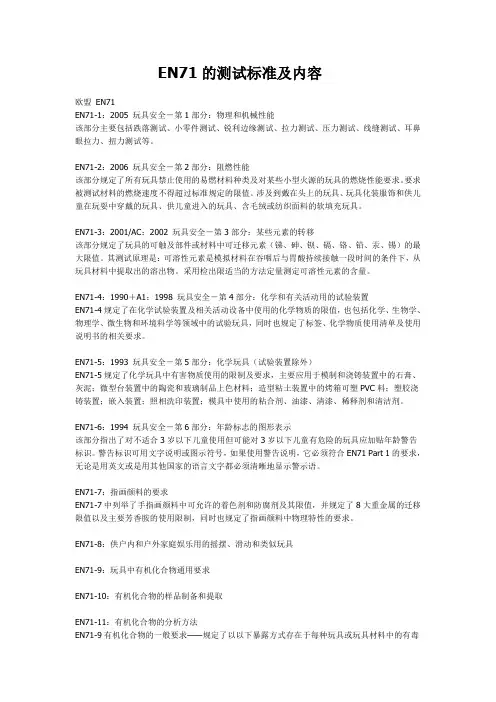
EN71的测试标准及内容欧盟EN71EN71-1:2005 玩具安全-第1部分:物理和机械性能该部分主要包括跌落测试、小零件测试、锐利边缘测试、拉力测试、压力测试、线缝测试、耳鼻眼拉力、扭力测试等。
EN71-2:2006 玩具安全-第2部分:阻燃性能该部分规定了所有玩具禁止使用的易燃材料种类及对某些小型火源的玩具的燃烧性能要求。
要求被测试材料的燃烧速度不得超过标准规定的限值。
涉及到戴在头上的玩具、玩具化装服饰和供儿童在玩耍中穿戴的玩具、供儿童进入的玩具、含毛绒或纺织面料的软填充玩具。
EN71-3:2001/AC:2002 玩具安全-第3部分:某些元素的转移该部分规定了玩具的可触及部件或材料中可迁移元素(锑、砷、钡、镉、铬、铅、汞、锡)的最大限值。
其测试原理是:可溶性元素是模拟材料在吞咽后与胃酸持续接触一段时间的条件下,从玩具材料中提取出的溶出物。
采用检出限适当的方法定量测定可溶性元素的含量。
EN71-4:1990+A1:1998 玩具安全-第4部分:化学和有关活动用的试验装置EN71-4规定了在化学试验装置及相关活动设备中使用的化学物质的限值,也包括化学、生物学、物理学、微生物和环境科学等领域中的试验玩具,同时也规定了标签、化学物质使用清单及使用说明书的相关要求。
EN71-5:1993 玩具安全-第5部分:化学玩具(试验装置除外)EN71-5规定了化学玩具中有害物质使用的限制及要求,主要应用于模制和浇铸装置中的石膏、灰泥;微型台装置中的陶瓷和玻璃制品上色材料;造型粘土装置中的烤箱可塑PVC料;塑胶浇铸装置;嵌入装置;照相洗印装置;模具中使用的粘合剂、油漆、清漆、稀释剂和清洁剂。
EN71-6:1994 玩具安全-第6部分:年龄标志的图形表示该部分指出了对不适合3岁以下儿童使用但可能对3岁以下儿童有危险的玩具应加贴年龄警告标识。
警告标识可用文字说明或图示符号,如果使用警告说明,它必须符合EN71 Part 1的要求,无论是用英文或是用其他国家的语言文字都必须清晰地显示警示语。
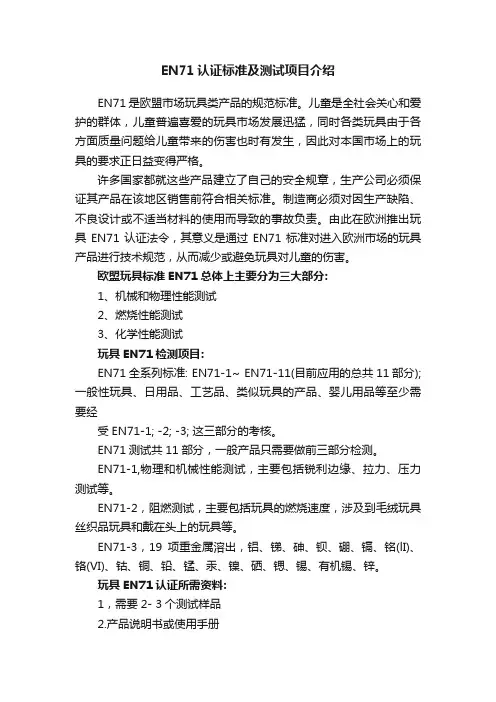
EN71认证标准及测试项目介绍EN71是欧盟市场玩具类产品的规范标准。
儿童是全社会关心和爱护的群体,儿童普遍喜爱的玩具市场发展迅猛,同时各类玩具由于各方面质量问题给儿童带来的伤害也时有发生,因此对本国市场上的玩具的要求正日益变得严格。
许多国家都就这些产品建立了自己的安全规章,生产公司必须保证其产品在该地区销售前符合相关标准。
制造商必须对因生产缺陷、不良设计或不适当材料的使用而导致的事故负责。
由此在欧洲推出玩具EN71认证法令,其意义是通过EN71标准对进入欧洲市场的玩具产品进行技术规范,从而减少或避免玩具对儿童的伤害。
欧盟玩具标准EN71总体上主要分为三大部分:1、机械和物理性能测试2、燃烧性能测试3、化学性能测试玩具EN71检测项目:EN71全系列标准: EN71-1~ EN71-11(目前应用的总共11部分);一般性玩具、日用品、工艺品、类似玩具的产品、婴儿用品等至少需要经受EN71-1; -2; -3; 这三部分的考核。
EN71测试共11部分,一般产品只需要做前三部分检测。
EN71-1,物理和机械性能测试,主要包括锐利边缘、拉力、压力测试等。
EN71-2,阻燃测试,主要包括玩具的燃烧速度,涉及到毛绒玩具丝织品玩具和戴在头上的玩具等。
EN71-3,19项重金属溶出,铝、锑、砷、钡、硼、镉、铭(lI)、铬(VI)、钴、铜、铅、锰、汞、镍、硒、锶、锡、有机锡、锌。
玩具EN71认证所需资料:1,需要2- 3个测试样品2.产品说明书或使用手册3.检测申请表(我司提供表格)4.零部件清单(BOM表)玩具EN71认证的流程:1.填写申请表2.提供产品的资料(说明书,电路原理图,如是多个型号的,提供型号差异列表)3.寄样4.测试5.出报告/证书。
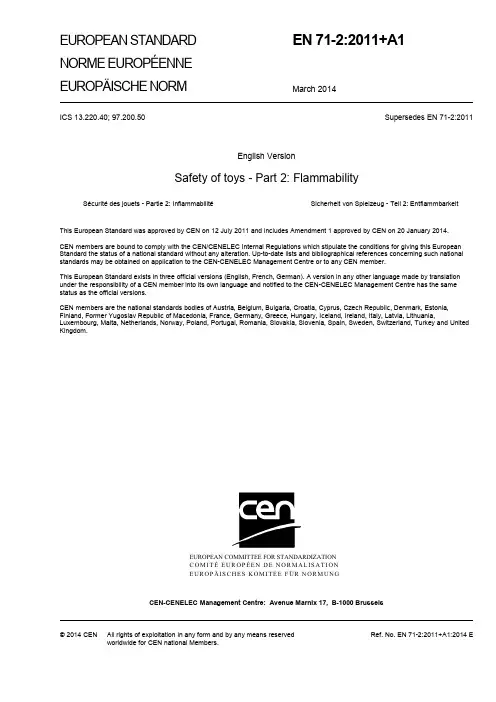
EUROPEAN STANDARD NORME EUROPÉENNE EUROPÄISCHE NORM EN 71-2:2011+A1 March 2014ICS 13.220.40; 97.200.50Supersedes EN 71-2:2011English VersionSafety of toys - Part 2: FlammabilitySécurité des jouets - Partie 2: Inflammabilité Sicherheit von Spielzeug - Teil 2: EntflammbarkeitThis European Standard was approved by CEN on 12 July 2011 and includes Amendment 1 approved by CEN on 20 January 2014.CEN members are bound to comply with the CEN/CENELEC Internal Regulations which stipulate the conditions for giving this European Standard the status of a national standard without any alteration. Up-to-date lists and bibliographical references concerning such national standards may be obtained on application to the CEN-CENELEC Management Centre or to any CEN member.This European Standard exists in three official versions (English, French, German). A version in any other language made by translation under the responsibility of a CEN member into its own language and notified to the CEN-CENELEC Management Centre has the same status as the official versions.CEN members are the national standards bodies of Austria, Belgium, Bulgaria, Croatia, Cyprus, Czech Republic, Denmark, Estonia, Finland, Former Yugoslav Republic of Macedonia, France, Germany, Greece, Hungary, Iceland, Ireland, Italy, Latvia, Lithuania, Luxembourg, Malta, Netherlands, Norway, Poland, Portugal, Romania, Slovakia, Slovenia, Spain, Sweden, Switzerland, Turkey and United Kingdom.EUROPEAN COMMITTEE FOR STANDARDIZATIONC O M I TÉ E U R OPÉE NDE N O R M A LI S A T I O NEUR O PÄIS C HES KOM I TE E FÜR NOR M UNGCEN-CENELEC Management Centre: Avenue Marnix 17, B-1000 Brussels© 2014 CEN All rights of exploitation in any form and by any means reservedworldwide for CEN national Members.Ref. No. EN 71-2:2011+A1:2014 EEN 71-2:2011+A1:2014 (E)2Contents PageForeword (4)Introduction .........................................................................................................................................................6 1Scope (see A.2) ......................................................................................................................................7 2Normative references ............................................................................................................................7 3Terms and definitions ...........................................................................................................................7 4 Requirements .........................................................................................................................................9 4.1 General requirements (see A.3) ............................................................................................................9 4.2 Toys to be worn on the head (see A.4) ................................................................................................9 4.2.1 General ....................................................................................................................................................9 4.2.2Beards, moustaches, wigs, etc., made from hair, pile or material with similar features (e.g. free-hanging ribbons, paper, cloth strands or other flowing elements), which protrude 50 mm or more from the surface of the toy ..................................................................................... 10 4.2.3Beards, moustaches, wigs, etc., made from hair, pile or material with similar features (e.g. free-hanging ribbons, paper, cloth strands or other flowing elements), which protrude less than 50 mm from the surface of the toy ................................................................................... 10 4.2.4 Full or partial moulded head masks ................................................................................................. 10 4.2.5 Flowing elements of toys to be worn on the head (except those covered by 4.2.2 and 4.2.3), hoods, head-dresses, etc. and masks not covered by 4.2.4 which partially or fully cover the head (e.g. fabric and cardboard masks, eye masks, face masks), but excluding those items covered by 4.3 ................................................................................................................ 11 4.3 Toy disguise costumes and toys intended to be worn by a child in play (see A.5) .................... 11 4.4 Toys intended to be entered by a child (see A.6) ............................................................................ 11 4.5 Soft-filled toys (see A.7) (11)5 Test methods ....................................................................................................................................... 12 5.1 General ................................................................................................................................................. 12 5.1.1 Test burner .......................................................................................................................................... 12 5.1.2 Conditioning and test chamber ......................................................................................................... 12 5.1.3 Test flame ............................................................................................................................................ 12 5.2 Test relating to beards, moustaches, wigs, etc., made from hair, pile or material with similar features (e.g. free-hanging ribbons, paper, cloth strands or other flowing elements), which protrude 50 mm or more from the surface of the toy ....................................... 12 5.2.1 Test flame ............................................................................................................................................ 12 5.2.2 Test burner position ........................................................................................................................... 12 5.2.3 Test performance ................................................................................................................................ 12 5.3 Test relating to beards, moustaches, wigs, etc., made from hair, pile or material with similar features (e.g. free-hanging ribbons, paper, cloth strands or other flowing elements), which protrude less than 50 mm from the surface of the toy, and full or partial moulded head masks (see A.8) ......................................................................................................... 12 5.3.1 Test flame ............................................................................................................................................ 13 5.3.2 Test burner position ........................................................................................................................... 13 5.3.3 Test performance ................................................................................................................................ 13 5.4 Test relating to flowing elements of toys to be worn on the head (except those covered by 4.2.2 and 4.2.3), hoods, head-dresses, etc. and masks not covered by 4.2.4 which partially or fully cover the head (e.g. fabric and cardboard masks, eye masks, face masks), toy disguise costumes and toys intended to be entered or worn by a child (see A.9) ...................... 13 5.4.1 Preparation of test sample ................................................................................................................. 13 5.4.2Holding the test sample (14)EN 71-2:2011+A1:2014 (E)35.4.3 Test flame ............................................................................................................................................. 14 5.4.4 Test burner position ............................................................................................................................ 15 5.4.5 Test performance ................................................................................................................................ 15 5.4.6 Results .................................................................................................................................................. 15 5.5 Test for soft-filled toys ........................................................................................................................ 16 5.5.1 Test flame ............................................................................................................................................. 16 5.5.2 Test burner position ............................................................................................................................ 16 5.5.3Test performance ................................................................................................................................ 16 Annex A (informative) Background and rationale for this European Standard .......................................... 17 A.1General ................................................................................................................................................. 17 A.2Scope .................................................................................................................................................... 17 A.3General requirements (see 4.1) .......................................................................................................... 17 A.4Toys to be worn on the head (see 4.2) .............................................................................................. 17 A.5Toy disguise costumes and toys intended to be worn by a child in play (see 4.3) ...................... 18 A.6Toys intended to be entered by a child (see 4.4) ............................................................................. 18 A.7Soft-filled toys (see 4.5) ...................................................................................................................... 18 A.8Test relating to full or partial moulded head masks (see 5.3)......................................................... 18 A.9 Test relating to toy disguise costumes and toys intended to be entered by a child (see 5.4) ......................................................................................................................................................... 18 Annex B (informative) Significant technical changes between this European Standard and the previous version .................................................................................................................................. 20 Annex ZA (informative) Clauses of this European Standard addressing essential requirements or other provisions of EU Directives (21)Bibliography (22)EN 71-2:2011+A1:2014 (E)ForewordThis document (EN 71-2:2011+A1:2014) has been prepared by Technical Committee CEN/TC 52 “Safety of toys”, the secretariat of which is held by DS.This European Standard shall be given the status of a national standard, either by publication of an identical text or by endorsement, at the latest by September 2014, and conflicting national standards shall be withdrawn at the latest by September 2014.Attention is drawn to the possibility that some of the elements of this document may be the subject of patent rights. CEN [and/or CENELEC] shall not be held responsible for identifying any or all such patent rights.This document supersedes !EN 71-2:2011".This document includes Amendment 1 approved by CEN on 2014-01-20.The start and finish of text introduced or altered by amendment is indicated in the text by tags !".Annex B provides details of significant technical changes between this European Standard and the previous edition.This European Standard has been prepared under a mandate given to CEN by the European Commission and the European Free Trade Association, and supports essential requirements of EU Directive(s).For relationship with EU Directive(s), see informative Annex ZA, which is an integral part of this European Standard.This European Standard constitutes the second part of the European Standard on safety of toys and should be read in conjunction with Part 1.This European Standard for safety of toys consists of the following parts:— Part 1: Mechanical and physical properties— Part 2: Flammability— Part 3: Migration of certain elements— Part 4: Experimental sets for chemistry and related activities— Part 5: Chemical toys (sets) other than experimental sets— Part 7: Finger paints — Requirements and test methods— Part 8: Activity toys for domestic use— Part 9: Organic chemical compounds — Requirements— Part 10: Organic chemical compounds — Sample preparation and extraction— Part 11: Organic chemical compounds — Methods of analysis4EN 71-2:2011+A1:2014 (E)NOTE 1 In addition to the above parts of EN 71, the following guidance documents have been published:— CEN Report, !CR 14379", Classification of toys — Guidelines,— CEN Technical Report !CEN/TR 15071", Safety of toys — National translations of warnings and instructions for use in EN 71, and— CEN Technical Report !CEN/TR 15371", Safety of toys —Replies to requests for interpretation of EN 71–1, EN 71–2, and EN 71–8.NOTE 2 Different legal requirements may exist in non-EU countries.According to the CEN/CENELEC Internal Regulations, the national standards organizations of the following countries are bound to implement this European Standard: Austria, Belgium, Bulgaria, Croatia, Cyprus, Czech Republic, Denmark, Estonia, Finland, Former Yugoslav Republic of Macedonia, France, Germany, Greece, Hungary, Iceland, Ireland, Italy, Latvia, Lithuania, Luxembourg, Malta, Netherlands, Norway, Poland, Portugal, Romania, Slovakia, Slovenia, Spain, Sweden, Switzerland, Turkey and the United Kingdom.5EN 71-2:2011+A1:2014 (E)IntroductionThis European Standard aims at reducing as far as possible those hazards which are not evident to users; it does not cover inherent hazards that are obvious to children or the persons in charge of them. Assuming that the toys are used in the intended manner, they should not present any further hazard to children for whom they are intended (according to the Directive 2009/48/EC “intended for use by” means that a parent or supervisor shall reasonably be able to assume by virtue of the functions, dimensions and characteristics of a toy that it is intended for use by children of the stated age group). Allowance should also be made for foreseeable use, bearing in mind the behaviour of children who do not generally share the same degree of care as the average adult user.As a general rule, toys are designed and manufactured for particular ages of children. Their characteristics are related to the age and stage of development of the children, and their use presupposes certain aptitudes.Accidents are frequently due to a toy either being given to a child for whom it is not intended, or being used for a purpose other than that for which it was designed. Great care should therefore be taken when choosing a toy or game; account should be taken of the mental and physical development of the child who will be using it.The requirements of this European Standard do not release parents or carers from their responsibility of watching over the child while he or she is playing.6EN 71-2:2011+A1:2014 (E)71 Scope (see A.2)This European Standard specifies the categories of flammable materials which are prohibited in all toys, and requirements concerning flammability of certain toys when they are subjected to a small source of ignition.The test methods described in Clause 5 are used for the purposes of determining the flammability of toys under the particular test conditions specified. The test results thus obtained cannot be considered as providing an overall indication of the potential fire hazard of toys or materials when subjected to other sources of ignition.This European Standard includes general requirements relating to all toys and specific requirements and methods of test relating to the following toys, which are considered as being those presenting the greatest hazard:— toys to be worn on the head: beards, moustaches, wigs, etc. made from hair , pile or material with similarfeatures ; masks; hoods, head-dresses, etc.; flowing elements of toys to be worn on the head, but excluding paper novelty hats of the type usually supplied in party crackers;— toy disguise costumes and toys intended to be worn by a child in play;— toys intended to be entered by a child;— soft-filled toys.NOTE Additional requirements for flammability of electric toys are specified in EN 62115.2 Normative referencesThe following referenced documents are indispensable for the application of this document. For dated references, only the edition cited applies. For undated references, the latest edition of the referenced document (including any amendments) applies.EN ISO 2431:1996, Paints and varnishes — Determination of flow time by use of flow cups (ISO 2431:1993, including Technical Corrigendum 1:1994)EN ISO 6941:2003, Textile fabrics - Burning behaviour - Measurement of flame spread properties of vertically oriented specimens (ISO 6941:2003)3 Terms and definitionsFor the purposes of this document, the following terms and definitions apply.3.1 flammability ability of a material or a product to burn with a flame under specified test conditions3.2 flaming debris material that becomes detached from the sample during the test procedure and continues to flame as it fallsEN 71-2:2011+A1:2014 (E)83.3 hair slender flexible fibres intended to represent human or animal hair3.4 soft-filled toy toy, clothed or unclothed, with soft body surfaces and filled with soft material, readily allowing compression of the main part of the toy with the hand3.5 surface flash rapid spread of flame over the surface of a material without ignition of its base structure at the same time3.6 molten drips falling droplets of molten material3.7 flammable liquid liquid having a flash point ≥ 23 °C and ≤ 60 °C3.8 highly flammable liquid liquid having a flash point < 23 °C and initial boiling point > 35 °C3.9 extremely flammable liquid liquid having a flash point < 23 °C and initial boiling point ≤35 °C3.10 flammable gas gas or gas mixture having a flammable range with air at 20 °C and a standard pressure of 101,3 kPa3.11 chemical toy toy intended for the direct handling of chemical substances and mixtures and which is used in a manner appropriate to a given age-group and under the supervision of an adult3.12 material with similar features material having the ability to flow like hair , to hang closely to the head and continue to move on its own after the head is rotated then stopped3.13 moulded head mask mask that is moulded to the contours of the head or faceNOTE Definitions for flammable liquid , highly flammable liquid , extremely flammable liquid and flammable gas have been extracted from REGULATION (EC) No 1272/2008 OF THE EUROPEAN PARLIAMENT AND OF THE COUNCIL of 16 December 2008 on classification, labelling and packaging of substances and mixtures, amending and repealing Directives 67/548/EEC and 1999/45/EC, and amending Regulation (EC) No 1907/2006.EN 71-2:2011+A1:2014 (E)4 Requirements4.1 General requirements (see A.3)NOTE 1 Words in italics are defined in Clause 3 (Terms and definitions). Additional information on the background and rationale for various requirements is given in Annex A.NOTE 2 According to Directive 2009/48/EC the following safety requirements apply regarding cleaning and washing: “A toy intended for use by children under 36 months must be designed and manufactured in such a way that it can be cleaned. A textile toy shall, to this end, be washable, except if it contains a mechanism that may be damaged if soak washed. The toy shall fulfil the safety requirements also after having been cleaned in accordance with this point from the Directive and the manufacturer’s instructions.”. The manufacturer should, if applicable, provide instructions on how the toy has to be cleaned. This information is not exhaustive and Directive 2009/48/EC and the associated guidance documents should be consulted for further details.The following materials shall not be present in toys:— celluloid (cellulose nitrate), except when used in varnish, paint or glue, or in balls of the type used for table tennis or similar games, and— materials with the same behaviour in fire as celluloid (see A.3).Specific materials to which the test flame is applied in order to check compliance of the toy with requirements in 4.2 to 4.5 are considered to comply with the above requirements if the toy meets its appropriate requirements in 4.2 to 4.5:— materials with a piled surface which produce surface flash when a flame is applied to the tested material under the conditions described in 5.5.1 and 5.5.2. Piled surfaces showing no momentary area of flame over the area of the piled surface remote from the test flame are considered to meet this requirement;In addition, toys shall not contain flammable gases, extremely flammable liquids, highly flammable liquids, flammable liquids and flammable gels except as provided for below:— flammable liquids and flammable gels supplied in sealed containers having a maximum volume of 15 ml per container;— highly flammable liquids and flammable liquids being entirely retained within a porous material in capillary channels of writing instruments;— flammable liquids with a viscosity greater than 260 × 10−6 m2/s corresponding to a flow time of more than38 s when determined in accordance with EN ISO 2431 using cup No. 6;!— highly flammable liquids contained in chemical toys, and in olfactory board games, cosmetic kits and gustative games, as defined in 2009/48/EC."NOTE 3 Different legal requirements may exist in non-EU countries.4.2 Toys to be worn on the head (see A.4)4.2.1 GeneralThe requirements of 4.2 apply to:— beards, moustaches, wigs, etc. made from hair, pile or material with similar features,9EN 71-2:2011+A1:2014 (E)10 — moulded and fabric masks,— hoods, head-dresses, etc.,— flowing elements of toys to be worn on the head,but not to paper novelty hats of the type usually supplied in party crackers (see A.4).When a product incorporates several features, for example a hat with an attached mask and hair , each part shall be tested separately to the applicable clause relevant to that particular part of the toy.Attachments made from elastic or string which are used for the purpose of securing a mask, hat, etc. on the head shall not be tested.4.2.2 Beards, moustaches, wigs, etc., made from hair, pile or material with similar features (e.g. free-hanging ribbons, paper, cloth strands or other flowing elements), which protrude 50 mm or more from the surface of the toyWhen tested according to 5.2, the duration of flaming shall not be more than 2 s after the removal of the test flame.In addition, if ignition occurs, the maximum burnt length of hair , pile, or material with similar features shall not be:a) more than 50 % of the greatest initial length, when the initial length was 150 mm or more, orb) more than 75 % of the greatest initial length, when the initial length was less than 150 mm.When determining whether materials are required to be tested under 4.2.2, the distance by which the material protrudes shall be measured without applying tension to the protruding part, e.g. curly hair is not straightened. Plaits or braided hair shall be fully released and combed, where possible, before testing.4.2.3 Beards, moustaches, wigs, etc., made from hair, pile or material with similar features (e.g. free-hanging ribbons, paper, cloth strands or other flowing elements), which protrude less than 50 mm from the surface of the toyWigs, etc. made from hair , pile or material with similar features which protrude 5 mm or less from the surface of the toy are regarded as head-dresses and are covered by 4.2.5.When tested in accordance with 5.3, the duration of flaming shall not be more than 2 s after the removal of the test flame, and the maximum distance between the upper edge of the burnt area and the point of application of the test flame shall not be more than 70 mm.4.2.4 Full or partial moulded head masksWhen tested in accordance with 5.3, the duration of flaming shall not be more than 2 s after the removal of the test flame. The maximum distance between the upper edge of the burnt area and the point of application of the test flame shall not be more than 70 mm.This requirement does not apply to moulded eye masks that neither cover the chin nor a cheek as they are covered by 4.2.5.4.2.5 Flowing elements of toys to be worn on the head (except those covered by 4.2.2 and 4.2.3), hoods, head-dresses, etc. and masks not covered by 4.2.4 which partially or fully cover the head (e.g. fabric and cardboard masks, eye masks, face masks), but excluding those items covered by 4.3When tested in accordance with 5.4, the rate of spread of flame of the test sample shall not exceed 10 mm/s or the test sample shall self-extinguish.4.3 Toy disguise costumes and toys intended to be worn by a child in play (see A.5)These include, for example, cowboy suits, nurses’ outfits and long flowing capes not attached to headwear covered by 4.2.5.When tested in accordance with 5.4, the rate of spread of flame of the test sample shall not exceed 30 mm/s or the test sample shall self-extinguish.If the rate of spread of flame is between 10 mm/s and 30 mm/s, the appropriate part(s) of the toy and the packaging shall be permanently marked with the following warning: “Warning. Keep away from fire”.4.4 Toys intended to be entered by a child (see A.6)These include for example toy tents, puppet theatres, wigwams and play tunnels.When tested in accordance with 5.4, the rate of spread of flame of the test sample shall not exceed 30 mm/s or the test sample shall self-extinguish.If the test sample has a rate of spread of flame greater than 20 mm/s when tested in accordance with 5.4, there shall be no flaming debris or molten drips.If the material has non-identical surfaces, both sides shall be tested.If the rate of spread of flame is between 10 mm/s and 30 mm/s, the appropriate part(s) of the toy and the packaging shall be permanently marked with the following warning: “Warning. Keep away from fire.”.4.5 Soft-filled toys (see A.7)The requirements of this subclause do not apply to soft-filled toys or soft-filled parts of a toy that cannot be cuddled or hugged by a child during play.The requirements of this subclause do not apply to toys which, when positioned in accordance with 5.5.3, present a maximum unhindered vertical soft-filled height of 150 mm or less.Soft-filled toys shall be tested as supplied, including any clothing or cover present with the toy and, if considered to be more onerous, with the clothes or cover removed if removal can be accomplished without damage to the clothes, cover or toy.When tested in accordance with 5.5, the rate of spread of flame on the surface shall not be more than 30 mm/s or the toy shall self-extinguish.5 Test methods5.1 General5.1.1 Test burnerThe test flame shall be obtained from a burner as described in EN ISO 6941:2003, Annex A and shall be operated with butane or propane gas.5.1.2 Conditioning and test chamberBefore each test, the toys or samples shall be conditioned for at least 7 h in an atmosphere having a temperature of (20 ± 5) °C and a relative humidity of (65 ± 5) %.Carry out the tests in a test chamber in which the movement of air is less than 0,2 m/s at the start of the test and is not affected by operation of mechanical apparatus during the test. It is essential that the volume of air in the test chamber is not affected by a reduction in the level of oxygen concentration. When an open fronted chamber is used for the test, ensure that the test sample is at least 300 mm from the walls of the chamber. Maintain the chamber at 10 °C to 30 °C and at a relative humidity of 15 % to 80 % prior to the test being carried out.The samples shall be tested within 5 min of removal from the conditioning atmosphere.5.1.3 Test flameLight the burner described in 5.1.1 and pre-heat for a minimum of 2 min.The required height of the flame shall be measured from the end of the burner tube to the top of the flame with the burner in the vertical position.5.2 Test relating to beards, moustaches, wigs, etc., made from hair, pile or material with similar features (e.g. free-hanging ribbons, paper, cloth strands or other flowing elements), which protrude 50 mm or more from the surface of the toy5.2.1 Test flameAdjust the flame height to (20 ± 2) mm.5.2.2 Test burner positionVertical.5.2.3 Test performanceMeasure the length of the hair, pile or material with similar features and position the toy so that the largest dimension of the hair, pile or material with similar features hangs vertically or as near vertically as possible.Apply the test flame for (2 ± 0,5) s to the lower edge or ends of the sample material so that the flame penetrates the element by approximately 10 mm.If ignition occurs, measure the duration of flaming and the maximum burnt length, i.e. the maximum length of the hair, pile or material with similar features that has been burnt.5.3 Test relating to beards, moustaches, wigs, etc., made from hair, pile or material with similar features (e.g. free-hanging ribbons, paper, cloth strands or other flowing elements),。
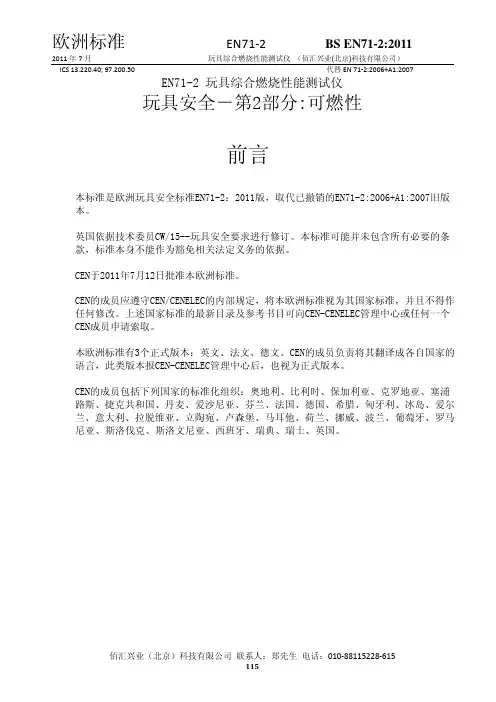
欧洲标准 EN71‐2 BS EN71-2:20112011年7月 玩具综合燃烧性能测试仪 (佰汇兴业(北京)科技有限公司)ICS 13.220.40; 97.200.50 代替EN 71‐2:2006+A1:2007EN71-2 玩具综合燃烧性能测试仪玩具安全-第2部分:可燃性前言本标准是欧洲玩具安全标准EN71-2:2011版,取代已撤销的EN71-2:2006+A1:2007旧版本。
英国依据技术委员CW/15--玩具安全要求进行修订。
本标准可能并未包含所有必要的条款,标准本身不能作为豁免相关法定义务的依据。
CEN于2011年7月12日批准本欧洲标准。
CEN的成员应遵守CEN/CENELEC的内部规定,将本欧洲标准视为其国家标准,并且不得作任何修改。
上述国家标准的最新目录及参考书目可向CEN-CENELEC管理中心或任何一个CEN成员申请索取。
本欧洲标准有3个正式版本:英文、法文、德文。
CEN的成员负责将其翻译成各自国家的语言,此类版本报CEN-CENELEC管理中心后,也视为正式版本。
CEN的成员包括下列国家的标准化组织:奥地利、比利时、保加利亚、克罗地亚、塞浦路斯、捷克共和国、丹麦、爱沙尼亚、芬兰、法国、德国、希腊、匈牙利、冰岛、爱尔兰、意大利、拉脱维亚、立陶宛、卢森堡、马耳他、荷兰、挪威、波兰、葡萄牙、罗马尼亚、斯洛伐克、斯洛文尼亚、西班牙、瑞典、瑞士、英国。
EN71-2 目录1 范围(见A.2) (117)2 引用标准 (118)3 术语和定义 (118)4 要求 (118)4.1 概述(见A.3) (118)4.2 头戴玩具(见A.4) (118)4.2.1 一般要求 (118)4.2.2 胡须、触须、假发等,由头发、毛绒玩具类似特性的材料(如飘逸丝带/纸/布条等)制成,其到表面的长度≥50mm (119)4.2.3 胡须、触须、假发等,由头发、毛绒玩具类似特性的材料(如飘逸丝带/纸/布条等)制成,其到表面的长度<50mm (119)4.2.4 全部或部分模塑玩具 (119)4.2.5 头戴玩具的飘逸饰品(4.2.2、4.2.3所述产品除外)如头巾、兜帽、头戴物等,以及部分或全部戴在头上的纤维面具(4.3所述产品除外) (119)4.3 玩具化妆服饰和供儿童在玩耍中穿戴的玩具(见A.4) (119)4.4 供儿童进入的玩具(见A.5) (119)4.5 含毛绒或纺织面料的软填充玩具(动物和公仔等) (120)5 测试方法 (120)5.1 概述 (120)5.2 对于从玩具表面伸出部分大于或等于50mm的由头发、毛绒或具有相似特征的材料(如自由悬挂的丝带、纸带或布带)制成的胡须、触须、假发等材料的测试 (120)5.2.1 测试火焰 (120)5.2.2 测试灯的位置 (121)5.2.3 试验过程 (121)5.3 对于从玩具表面伸出部分小于50mm的由头发、毛绒或具有相似特征的材料(如自由悬挂的丝带、纸带或布带)制成的胡须、触须、假发等材料,及包括套在头上的和没有头发、毛绒或类似材料的、模塑的全部或部分的头戴面具的测试 (121)5.3.1 测试火焰 (121)5.3.2 测试灯的位置 (121)5.3.3 试验过程 (121)5.4 头戴玩具的飘逸饰品(4.2.2、4.2.3所述产品除外)如头巾、兜帽、头戴物等,以及部分或全部戴在头上的纤维面具、玩具化妆服饰和供儿童进入的玩具的测试(见A.7) (121)5.4.1 样品的准备 (121)5.4.2 样品的固定 (121)5.4.3 测试火焰 (122)5.4.4 测试灯的位置 (122)5.4.5 试验过程 (123)5.4.6 测试结果 (123)5.5 软填充玩具的测试 (123)5.5.1 测试火焰 (123)5.5.2 测试灯的位置 (123)5.5.3 试验过程 (123)附录A 本标准的背景及相关基本原理 (124)1 范围(参见A.2)EN71 这一部分规定了所有玩具上禁止使用的易燃材料种类以及对某些接触小型火源的玩具的易燃性的要求。


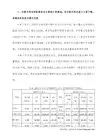
EN71玩具安全认证规范标准第1部分:物理和机械性能该部分主要包括跌落测试、小零件测试、锐利边缘测试、拉力测试、压力测试、线缝测试、耳鼻眼拉力、扭力测试等。
EN71-2:2006玩具安全认证-第2部分:阻燃性能该部分规定了所有玩具禁止使用的易燃材料种类及对某些小型火源的玩具的燃烧性能要求。
要求被测试材料的燃烧速度不得超过标准规定的限值。
涉及到戴在头上的玩具、玩具化装服饰和供儿童在玩耍中穿戴的玩具、供儿童进入的玩具、含毛绒或纺织面料的软填充玩具。
EN71-3:2001/AC:2002玩具安全认证-第3部分:某些元素的转移该部分规定了玩具的可触及部件或材料中可迁移元素(锑、砷、钡、镉、铬、铅、汞、锡)的最大限值。
其测试原理是:可溶性元素是模拟材料在吞咽后与胃酸持续接触一段时间的条件下,从玩具材料中提取出的溶出物。
采用检出限适当的方法定量测定可溶性元素的含量。
EN71-4:1990+A1:1998玩具安全认证-第4部分:化学和有关活动用的试验装置EN71-4规定了在化学试验装置及相关活动设备中使用的化学物质的限值,也包括化学、生物学、物理学、微生物和环境科学等领域中的试验玩具,同时也规定了标签、化学物质使用清单及使用说明书的相关要求。
EN71-5:1993玩具安全认证-第5部分:化学玩具(试验装置除外)EN71-5规定了化学玩具中有害物质使用的限制及要求,主要应用于模制和浇铸装置中的石膏、灰泥;微型台装置中的陶瓷和玻璃制品上色材料;造型粘土装置中的烤箱可塑PVC料;塑胶浇铸装置;嵌入装置;照相洗印装置;模具中使用的粘合剂、油漆、清漆、稀释剂和清洁剂。
EN71-6:1994玩具安全认证-第6部分:年龄标志的图形表示该部分指出了对不适合3岁以下儿童使用但可能对3岁以下儿童有危险的玩具应加贴年龄警告标识。
警告标识可用文字说明或图示符号,如果使用警告说明,它必须符合EN71 Part 1的要求,无论是用英文或是用其他国家的语言文字都必须清晰地显示警示语。
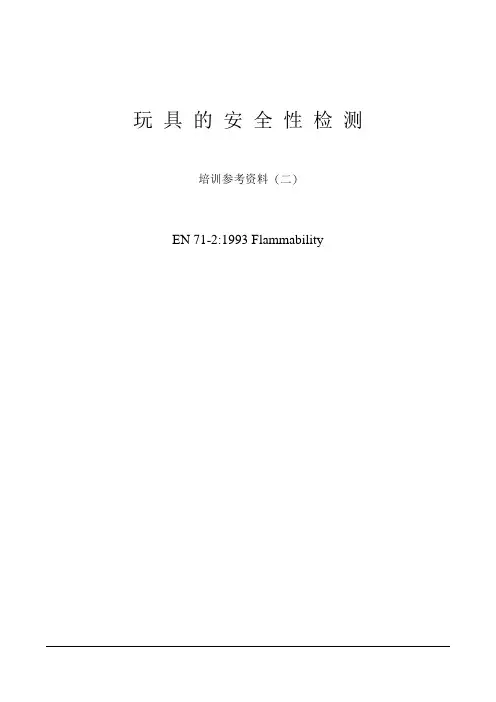
玩具的安全性检测培训参考资料(二)EN 71-2:1993 FlammabilityEN71-2 Flammability以下内容按标准的顺序编排3.定义3.1易燃性: 在规定的试验条件下,材料或产品燃烧产生火焰的能力.3.2燃烧焰渣: 在试验过程中从样品分离出来并在落下时仍继续燃烧的物质.3.3自灭: 表示样品着火但在未到达二记号线之前即自行熄灭的现象.3.4代表性试样: 玩具上的每人样品(纺织物),若不足80mm ×600mm时,不须作燃烧试验.3.5头发: 设计上用来代表头了的材料.3.6软件填充玩具: 不论玩具是否着衣,其身躯圾面由纺织品或带毛的材料制成,体内充满了软性填充材料(例如膨胀的聚苯乙烯颗粒,聚酯纤维或聚氨基酸酯泡沬),容易用手挤压.3.7表面闪光: 燃烧时,火焰在基体表面上的材料急速漫延,而基体材料没有燃烧的现象. 4技术要求4.1一般要求下列材料不得用于制造玩具a 赛璐路(硝酸纤维)或在时具有同样我的材料(当其用于清漆或油漆中时例外).b 在接触火焰时会出现表面闪光的表面有毛的材料.c 玩具不能含有易燃气体、极度易燃的液体、易燃液体和易燃固体.下列情况除外:d 1) 单个密封容器内的易燃液体,每个容器的最大容量为15ml;2)完全储存于书写工具细管内的疏松材料中的高度易燃液体和易燃固体4.2胡子、髭须、假发、假面具和其它戴在头上的产品及其附属材料(如绳).1)胡子、髭须、假发、假面具和其它戴在头上的产品及其附属物品,若表面绒毛长度大于或等于50mm者:a 按照第5.5条试验时,在移开火焰之后,其燃烧的持续时间不得超过2秒b 此外,如果试样点燃,则绒毛的最大残留长度应为:1)若原长度大于或等于150mm,应不少于归大原长度的50%2)若原长度小于150mm,应不少于最大原长度的25%c 对波浪开毛,发其长度以拉直的长度计算.d 玩具的试验是在通常的使用状态并以最不利的状态进行,例如:辫子拆散.2) 胡子、髭须、假发、假面具和其它戴在头上的附有毛发及其它附属材料的产品(如纸绳.但作紧固用的除外).其绒毛长度小于50mm者.a 当按5.6条进行试验时,在移开火焰后,其燃烧时间不得大于2秒.b 从点火点测量被燃烧面的最大尺寸,不得大于70mmc 绒毛,毛发或其它附着和的纸板假面具除外,那些两眼中间到头顶的距离大于130mm的纸板假面具应满足本要求.4.3 化妆服装和打算穿在小孩身上的其它玩具(除第4.2条提及的产品和新颖的纸帽外).a 当这些玩具按5.7条试验时,火焰蔓延速度应小于30mm/秒.b 如果火焰蔓延的速度在10mm/秒和30mm/秒之间,则这玩具和其包装上圴应标有下列警告:“Warning! Keep away from fire”4.4 能让小孩进入的玩具.a 该类玩具的试样在按5.8方法试验时,火焰的燃烧速度应不大于30mm/秒b 若试样的燃烧速度大于20mm/秒,则不应有焰渣跌落.c 若试样自灭,即为合格d 若燃烧的速度介于10mm/秒和30mm/秒之间,则玩具及其包装上均应标明以下警告: “Warning! Keep away from fire”4.5 软件填充玩具a 具有绒毛面向如丝绒、长毛绒、仿毛皮)或编织物表面的软件填充玩具(手、脚、头均由非编织品塑料做成的除外),在按5.8方法试验时,燃烧速度应不大于30mm/秒.b 玩具应按提供来时的状态进行试验,即:有衣物时应着上衣物试验.此外,如果在不损坏玩具和衣物的情况下可以除下衣物,则聊下衣物再进行一次试验.c 此要求只适用于呎寸大于150mm的玩具.5试验方法5.1概括(略)5.2条件和试验间a 测试前的玩具应在摄影氏20 ±5℃,相对湿度65 ±5%的条件下放置至少7个小时.b 测试应在空气流速小于02m/秒的试验间内进行.当试验柜为前面敞开时,应确保试样离墙壁至少300mm.在试验柜前,应予先控制试验间在摄氏10 ~30℃,相对湿度15~80%之间5.3试验火焰燃烧器符合ISO6941: 1984, 燃烧气体为丁烷气.火焰高度为燃烧头末端表面与火焰顶端的距离5.4化妆服装和儿童可进入的玩具的处理如果生产厂:a 指明此玩具不可洗,则不要在试验前洗或浸湿玩具.b 推荐了清洗可清洁的方法,应将玩具推荐的方法处理.c 没有指出清洗或清洁玩具的方法,应按下面的方法来处理.-将玩具浸泡在自来水(温度大约20℃)中,玩具的重量和水的比率至少为1:2.-让玩具持续浸泡1分钟.-排水后重复两次.再用去离子水漂洗玩具2分钟.-排水后用适当的方法将玩具晾干,然后将它恢复成原状.5.5关于胡子、髭须、假发、假面具和其它头戴的产品或其它表面大于50mm的险着材料的测试.a 使绒毛,头了或其它附着材料处于拉直状态,测量其长度.b 将玩具和绒毛、毛发或其它附着物的最大呎寸置于垂直或尽可能垂直的状态.c 燃烧头垂直放置,调整试验火焰高度为20 ±2mm.d 把火焰加于绒毛、毛发或其它附着物的下部边缘,并使火焰穿透对象约10mm.,持续2秒e 移开火焰后,检查是否点燃.f 如果点燃,应测量燃烧的持续时间和绒毛、毛发及其它附着物剩余的最小长度.g 计算绒毛、毛发或其它剩余附着物长度的是分比,如5.6有关胡须、髭须、假发、假面具和其它开戴到头上的附着材料,其自由长度小于50mm的产品主测试方法.a 把玩具垂直放置.b 燃烧头放在垂直位置,调整一个20 ±2mm高的火焰.c 把燃烧头调到45°角d 在离毛的最低点20mm之位置点火,保持燃烧头中心位与抟面为5 ±1mm的距离,点火时持续时间为5秒.e 移去火焰后,检查燃烧是否了生.f 若燃烧了生则测一燃烧持续时间和燃烧区域边缘到点火位置之间的最大距离.5.7化妆服装和儿童可进入的玩具的试验.a 在玩具上测量具有代表性的试样,若试样呎寸不够(80mm ×600mm),则该材料不用做此试验.b 剪取样品并按照它在玩具上出现的状况进行测试.(如沿着儿童站立时裤腿的方向)c 把样品放在试架上.使它的边缘和U型架的两脚对齐.把U型架固定好,以确保样品d 在U型架的装线位,装上棉疆,使其离样品表面的距离不大于2mme 将试架放在45°铁架上.f 燃烧器置于垂直位置,调节火焰高度为40 ±2mm,在样品边缘点火,保持燃烧头与样品边缘为30 ±2mm的距离,点火持续时间为10 ±1s.g 当第一条棉线烧断时开始计时,第二条棉线烧断时停止计时,计算燃烧速度:500/Δt.h 观察是否是有表面闪光现象.i 假若在10秒内材料不能燃着,可停止试验并认为该种材料合格.j 若材料的两面不相同,应别测试.5.8软件填充玩具的试验a 测量玩具的点火位置(作一个标记)到顶部的距离.以最易燃的方式交玩具头朝上垂直放置.b 燃烧头垂直放置,调火焰高度到20 ±2mm,然后使燃烧头与水平成45°位置.c 火与玩具接触时间为3秒,同时使:●燃烧头边缘和样品间距离约为5mm,且●点火位置在离玩具最易燃烧材料的下部边缘20mm到50mm处.e 移去火焰后,检查燃烧是否发生.f假若燃烧发生,测量燃烧持续时间和燃烧距离.g计算出燃烧速度R(mm/秒)───完────。
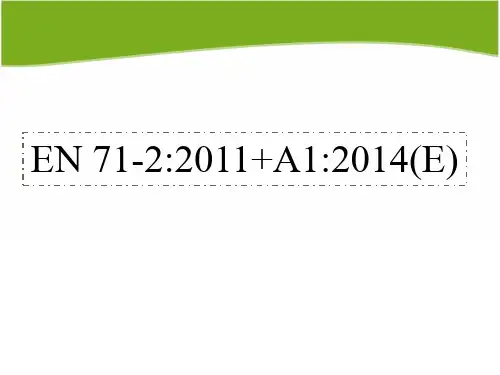
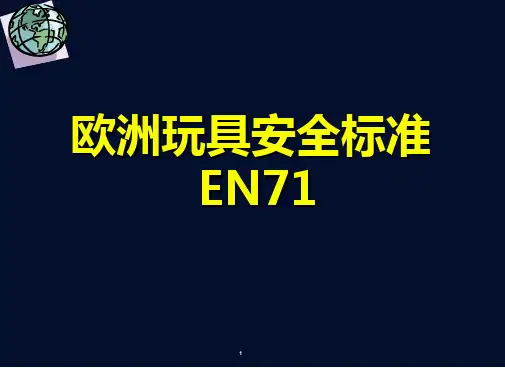
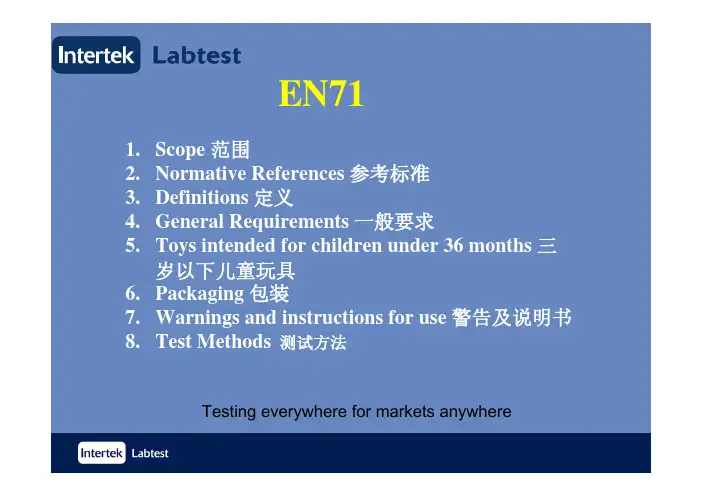
B) 若少于0.038mm,则须在30mmx30mm面积内在不充气或不破坏气球的情况下,双层塑料薄膜并有抽拉绳作为封口的玩具袋应:由透气的材料做成;或者)的要求*可触及的玻璃可用于制造36个月以上儿童的玩具,滥用测试前后都须符合该条的金属片与下垫面之间的间隙大于0.7mm,则金属片的边缘须符合上一点。
电导体、显微镜的盖玻片和载玻片的边缘无需警告语。
Testing everywhere for markets anywhere应提醒使用者注意锐利尖端的潜在危险。
Testing everywhere for markets anywhereTesting everywhere for markets anywhereTesting everywhere for markets anywhere本要求不适用于潜在座位表面宽度小于140mm的玩具。
不同类型折叠和滑动装置各有其具体要求(参见测试标准)驱动机构在进行跌落测试和冲击测试时,或倾翻测试时,不能有可触及的锐利边缘或锐利尖端及其它压伤部件暴露出来。
发条玩具上的钥匙和起动手柄与玩具主体的间隙Testing everywhere for markets anywhereTesting everywhere for markets anywhere成为小部件。
-口动式玩具内松散的部件在口动玩具耐久性测试后,不能形成小部件。
-安装在气球上的吹嘴在浸泡、扭力和拉力前后都不许有小部件。
Testing everywhere for markets anywhere风筝及其它飞行玩具的绳索,其电阻率应大于100兆欧每厘米。
要提醒用户注意放风筝的潜在危险:不要靠近架空电线和雷电时放风筝。
Testing everywhere for markets anywhere-须至少有1300mm2的透气面积,可以是两个最少间隔150mm的通气孔或任意等效面积的单个透气面。
-按照扭矩、拉力、跌落、撞击和压力测试前后,不能露出会落入眼睛的锐利边缘、锐利尖端或松散部件。
欧洲标准EN 71-2玩具安全标准-第2部分:易燃性欧洲标准EN71-2:2006具有英国标准的地位此英国标准是EN71-2:2006的官方英语版本,技术委员会CW/15玩具安全标准及附属委员会CW/15/-14化学要求,委托英国参与标准的准备,其有责任:-帮助询问者理解内容;-向合理的国际/欧洲委员会呈递有关询问者的理解或建议,告知英国利益;-监督相关的国际及欧洲发展,并在英国传播。
附属委员会制定的管理清单能在其秘书处得到。
国际或欧洲出版的英国标准可在BSI目录名为“国际标准索引”或搜索BSI电子目录或英国标准在线找到。
此出版物并不意味着包括合同中所有需要的条例。
使用者有责任正确运用。
符合英国标准并不意味着它从法律责任中豁免。
此欧洲标准由CEN在2005年11月30日批准.CEN成员必须遵循CEN/CENELEC内部规定。
该规定没有任何选择的保证欧洲标准的国家标准地位。
相关的国家标准参照的最新明细清单可向中央秘书处或任何一个成员申请获得.此欧洲标准有3个官方版本(英语、法语和德语)。
任何在CEN成员职责之下,以其它语言翻译的版本,通知中央秘书处后,具有同样的效力。
CEN成员是国家标准的主体:澳大利亚、比利时、捷克、丹麦、芬兰、法国、德国、希腊、匈牙利、冰岛、爱尔兰、意大利、卢森堡、马耳他、荷兰、挪威、葡萄牙、斯洛伐克、西班牙、瑞典、瑞士、英国CEN管理中心:rue de Stassart,36 B-1050 Brussels前言介绍1.范围2.参考标准3.术语和定义4.要求4.1一般要求(看A3)4.2戴在头上的玩具4.3玩具化装服饰和游戏中儿童穿戴的玩具4.4供儿童进入的玩具(看A6)4.5毛绒或纺织品表面的填充玩具(动物和洋娃娃等)5.测试方法5.1一般要求5.2对毛发,毛绒或从玩具表面伸出长度≥50mm的类似材料制成的胡子,髭须,假发等的测试(例如悬挂的缎带,纸条或布条)5.3对毛发,毛绒或从玩具表面伸出长度<50mm的类似材料制成的胡子,髭须,假发等,及全部或部分铸造的面具的测试5.4戴在头上玩具的飘拂部分(除4.2.2,4.2.3覆盖的玩具),头巾,头饰,和遮住部分或整个头部的的纺织面具,化妆服饰及供儿童进入的玩具的测试5.5对最大尺寸≤520mm的软体填充玩具的测试5.6对最大尺寸>520mm的软体填充玩具的测试6.测试报告附录A背景及此欧洲标准原则A1一般A2范围A3一般要求(看4.1)A4戴在头上玩具: 毛发,毛绒或类似材料制成的胡子,髭须,假发等,造型面具和纺织面具;头巾,头饰等;戴在头上玩具的飘拂部分,但排除聚会爆竹通常提供的纸质花饰帽(看4.2)A5玩具化妆服饰和游戏中儿童穿戴的玩具(看4.3)A6供儿童进入的玩具(看4.4)A7关于化妆服饰和供儿童进入的玩具的测试(看5.4.2)附录ZA此欧洲标准条款中提出的基本要求或EU官方指令的其他条例.参考书前言此文件(EN71-2:2006)由技术委员会CEN/TC52“玩具安全标准”DS秘书处准备。
中⽂版玩具安全标准EN711.2.⼀般要求:2.1.2.2.材料: 玩具⽣产⽤的材料应是新材料或是经过处理使其有害物不会超过标准要求.应⽬视⽆污染,对材料进⾏评估时,应⽤裸眼进⾏观察(不应通过放⼤镜观察).2.3.2.4.组装玩具:2.4.1.2.4.2. ⼉童组装玩具: 标准使⽤于⼉童组装的部件以及组装好的玩具.2.4.3.2.4.4. 成⼈组装玩具: 标准适⽤于组装好的玩具.根据装配的难度考虑,需要时,组装玩具应有详细的装配指引.如果它是需由成⼈组装或装配完投⼊使⽤前需由成⼈对其装配情况进⾏检查,则应特别指明.2.5.2.6.软塑料⽚:2.6.1.2.6.2. 玩具中的软塑料⽚,如果⾯积⼤于100mm×100 m m,⽽⽆任何衬底,平均厚度不得⼩于0.038m m;2.6.3.2.6.4. 对于⾯积⼤于100m m×100 mm,厚度⼩于0.038m m的软塑料⽚,其上任何⼀30mm×30 m m的⾯积上⾄少有该⾯积的1%开孔;2.6.5.2.6.6. 对于塑料⽓球,条件1.3.1的要求,适⽤于没充⽓或没破烂的双层厚度.2.7.2.8.玩具袋:由不透⽓的材料做成的玩具袋,如果开⼝周长⼤于380mm,不能采⽤抽/拉线或绳作为封⼝⽅法.2.9.2.10.玻璃:供3岁以上⼉童玩的玩具,在满⾜下列要求的条件下可以有可接触及到的玻璃(茶2.10.2.因玩具中的功能设计必须使⽤玻璃(例如:光学玩具/电灯泡.试验,装置⽤的玻璃).2.10.3.2.10.4.是⽤于加强作⽤的玻璃纤维.2.10.5.2.10.6.是实⼼玻璃弹⼦或⽤于做公仔眼睛的实⼼玻璃眼睛.2.11.2.12.1.2.12.2.对于可接触到的⾦属/玻璃的边,应不是有伤害性的利边.2.12.3.2.12.4.对于厚度⼩于或等于0.5m m的⾦属⽚,如果搭接在另⼀表⾯体上,其间距⼤于0.7m m,则该⾦属⽚的边缘应符合 1.6.1 的要求.2.12.5.2.12.6.⾦属(含螺丝等紧固件)和硬的聚合材料的边缘,应⽆可刺伤或擦伤⽪肤的⽪刺.2.12.7.2.12.8.对于功能必需⽤的利边(如显微镜的盖玻⽚),可⽤于供3岁以上⼉童玩的玩具中,但潜在的危险性应以⽂件描述出来.对于电接触功能的边缘/显微镜的载物玻璃⽚和盖玻⽚认为是功能性边缘,它们不需要警告语.2.13.2.14.尖点和铁线:铁线和可接触到⾮功能性尖点应是⽆伤害性的,具体要求为: 2.14.1.2.14.2.对于可接触到的尖点,应不是有伤害性的尖点(注:铅笔的头以及类似的写/画⽤具的头不作为尖点考虑).2.14.3.2.14.4.对于功能必需⽤的尖点,可⽤于供3岁以上⼉童玩的玩具中,但潜在的危险性应以⽂字描述出来,并符合 4.5.要求(对于电接触功能的尖点,被认为是功能性尖点不再需要警告语).2.14.8.对于那些含有⾦属线,并是供⼉童弯曲的玩具,以及在玩具中起架⼦/钢性/牢固性作⽤的⾦属线等,它们很可能被⼉童变曲玩耍(例如⽤在软件填充玩具中的铁线),经试验后⾦属线应不断裂和产⽣尖点,或突出玩具的外表⾯.2.15.2.16.凸出物:——对于突出玩具的表⾯垂直/或近似于垂直(以最不利的位置试验)的管/棒/杆或其它类似的刚性部件,可能伤害跌倒在该玩具上的⼉童,应加以保护,并且,该保护装置在经受试验后,应不被拉掉.——对于在⼩玩具上的凸出件,如果在上⾯加压⼒时翻倒,不会有伤害性,则该项要求不适⽤.——对于玩具⾬伞/其伞⾻的末端应保护.并且,其保护件在经拉⼒试验后,如果脱落,⽆⽑刺近似于圆形或球形.2.17.2.18.有相对运动部件的玩具:2.18.1.2.18.2.传动机构:有传动机构的玩具以及⽤钥匙上发条的玩具和有启动⼿柄的玩具应满⾜下列有关的要求:注:1. 下列A/B/C项的要求不适⽤于传动功能较⼩, 不会夹伤⼿指等的传动机构玩具.2. 供3岁以⼉童玩的玩具,参照 2.1.要求A.B. 玩具在经过跌落试验和冲击试验前/后,不应有可接触到的利边/尖点,以及不应出现夹伤⼿指等的潜在危险.C.D. 有传动机构的⼤型玩具,在经过翻倒试验前/后都不应有可接触到的利边/尖点以及不应出现夹⼿指等的潜在危险.E.F. 上发条的钥匙以及启动⼿柄与玩具硬性外壳之间的间隙应是<5m m或>12mm.钥匙/⼿柄上如果有孔,其孔的⼤于应<5mm.2.18.3.2.18.4.铰链:如果玩具的两部分分别≧250g,并⽤⼀个或两个以上的铰链连接,沿2.18.6.弹簧:A.B. 钟形弹簧: 若相邻两圈的距离⼤于或等于3mm,则应加以保护或使其不可接触.C.D. 拉⼒弹簧: 在弹簧承受40N的拉⼒时,若相邻两圈的距离⼤于或等于3mm,去掉拉⼒时弹簧⼜复原,则应加以保护或使其不可接触.E.F. 压缩弹簧: 如果能承受40N压⼒的弹簧在⾃由状态相邻两圈的距离⼤于或等于3mm,则应加以保护或使其不可接触. 如果压缩弹簧中有⼀根导轴,使得⼿指探针A(<3岁)不能沿簧距间隙插⼊5mm以上,则认为,这是⼀种保护.2.19.2.20.发射的玩具:2.20.1.2.20.2.⼀般要求:●硬性的发射物的端头的直径应:≧2mm●●在发射物的碰撞表⾯上的弹性物,进⾏60N拉⼒试验,应不脱落.注: 沿地⾯/轨道以及其它表⾯飞⾏的玩具,不作为发射玩具.2.20.3.2.20.4.不能贮存能量的发射玩具:●●飞镖形发射物的头应是钝的,或有碰撞⾯积不⼩于3cm2的弹性保护材料,发射物的头应是⾮⾦属,但⾯积不⼩于3cm2的磁性材料圆盘除外.●●直升飞机以及类似上升飞⾏的玩具,其螺旋桨外围应有保护环.2.20.5.2.20.6.可以贮存能量的发射玩具:●●最⼤发射动能应不超过:对于⽆弹性保护头的发射物: 0.08J●对于箭形发射物,如果最⼤动能⼤于0.08J,则应有弹性保护头,并且其弹性材料撞击⾯的最⼤动能不⼤于0.16J/cm2●●对于能发射⾮玩具配套的物料的玩具,以及发射动能⼤于0.08J的玩具,应符合要求的警告语.(为了减少造成眼睛受伤的危险,强烈建议制造商把玩具设计成除玩具本⾝专⽤弹射物外不能击发其它弹射物). .2.20.7.2.20.8.⼸和箭:●●箭头应是⾮⾦属材料,但⾯积不⼩于3cm2的磁性材料圆盘除外.●●最⼤动能不超过:●●0.08J 对于⽆弹性保护头的箭●●0.5J 对于弹性材料制造的箭或有弹性保护头的箭.●●箭的最⼤动能超过0.08J时,应有弹必保护头,并且其单位⾯积上的最⼤动能不⼤于0.16J/c m2.2.22.声响玩具:此标准不适⽤于⼝动玩具(如哨⼦/笛⼦),⼉童启动的玩具(如⿎)及磁带放⾳机/CD放⾳机和其它类似的电⼦玩具,但此类玩具配有⽿机或⽿塞,则须符合此要求:●●在⽆⼲扰的场合测量近⽿玩具发出的A-加权声量LpA不得超过80dB,使⽤Coupler测试时,则不得超过90dB.●●由摇铃或挤压玩具发出的A-加权单相发射声量LpA 1s不得超过85dB.●●由摇铃或挤压玩具发出的C-加权声量声量峰值LpC Peak不得超过110dB.●●如果玩具发出的C-加权声量声量峰值LpC Peak超过110dB,则应提醒使⽤者注意可能会产⽣的听⼒损害,见 4.8.3.4.2.⼀般要求:注:本要求不适⽤于:——纸⽚/纤维/橡⽪筋/纱绒/绳/绒⽑.——蜡笔/粉笔/铅笔等类似的⽆可拆卸部件的书写/绘画⼯具.——⽓球.——造型⽤粘⼟及类似制品.4.2.1.4.2.2. 玩具以及可拆卸的零件应不是⼩对象(按⼩对象试验),对于容易推或拉出来的⼩⽊结,认为是⼩对象.4.2.3.4.2.4. 玩具经扭⼒试验/拉⼒试验/跌落试验/冲击试验和压⼒试验后,应不产⽣可接触的⼩对象/利边/尖点,如有可接触的弹簧,则应符合要求.4.2.5.4.2.6. ⾦属物品的尖端或铁线的横截线段如果≦2mm,则认为是⼀个潜在的危险尖点.4.2.7.4.2.8. ⼤型玩具(重量⼤于4.5Kg,或投影⾯积⼤于0.26m2或体积⼤于0.08m3)按的要求进⾏试验,但⽤翻倒试验替代跌落试验.4.2.9.进⾏浸泡试验,(在浸泡试验中,玩具上松/脱出的油漆碎⽚不认作⼩物件).但厚的表⾯涂层碎⽚(例如清层漆层),本标准认作是⼩对象.注: 本要求对不适⽤于⼤型玩具/书纸⽚/纸卡等类似玩具.4.2.11.4.2.12.玩具表⾯和可接触的边缘应⽆⽑刺.4.2.13.4.2.14.供5个⽉以下⼉童玩的玩具的外壳,在经受中规定的试验后应⽆潜在有伤害性的破裂.如破裂不产⽣危险时则可接受.4.2.1材料产⽣影响结果的损坏.4.3.4.4.填充材料:4.4.1.4.4.2. 软的填材料中应⽆⾦属铁钉/针/刺等硬的或尖的物件.4.4.3.4.4.4. 软的填充玩具,如果含有⼩对象(例如发声部件/铃/碎泡沫)或其填充的泡沫材料能被撕碎,则其外罩应能经受线缝以及纺织品材料的拉⼒试验,如果产⽣破裂则应在10N⼒下不能插⼊探针 A.4.5.4.6.玩具上附着的塑料⽚:对于附着的玩具上的塑料⽚,如果按塑料薄膜的粘附性试验要求⽤0.04m m厚规检测证明能插⼊,然后,按线缝以及纺织品材料的要求进⾏拉⼒试验,如果塑料⽚被拉脱,并且⾯积⼤于100mm×100mm,则平均厚度应≧0.038mm.4.7.4.8.玩具上的绳:4.8.1.4.8.2. 玩具上的绳的最⼩厚度应不⼩于1.5mm.4.8.3.4.8.4. 玩具上的绳如果含有可打结形成环的附着物,则⾃由长度:●●在25N±2N的拉⼒下不长过220mm.●●在25N±2N的拉⼒下如果绳⼦被拉断,则断绳长度不应长过220mm,其断绳应是在不改变连接特性的情况下可再次连接在⼀起.4.8.5.4.8.6. 在25N±2N拉⼒下任何环形绳的周长应不超过380mm.4.8.7.4.8.9.4.8.10.横跨童床/围栏/婴⼉车等上固定的绳,在25±2N拉⼒下不应长过750mm,并且,伸长率不⼤于40%,警告语应符合要求.4.9.4.10.充有液体的玩具:4.10.1.4.10.3.4.10.4.充有液体的出⽛器应有符合的警告语注: 本要求不适⽤于装有液体的电池,以及装在容器中的⼿画涂料等.4.11.4.12.电驱动的玩具的最⼤限制速度:电驱动的座骑玩具的最⼤速度不应超过8Km/h 4.13.4.14.玻璃和瓷器:可接触的玻璃和瓷器不能⽤于供3岁以下⼉童玩的玩具中.5.6.包装:6.1.6.2.对于软塑料袋,如果开⼝周长⼤于380mm,则平均厚度应不⼩于0.038mm.6.3.6.4.对于开⼝周长⼤于380mm的软塑料袋,开⼝处不应有收缩绳等类似收⼝对象.注: 本要求不适⽤于:——在拆开包装时,就撕烂的吸塑材料包装膜.——符合 1.3.2要求的塑料袋.7.8.警告语和使⽤说明:8.1.8.2.⼀般要求:8.2.1.8.2.2. 制造商或代理商或进⼝商的在欧洲共同体国家内的名称/地址应出现在玩具上或包装上,并且清晰/可见/不易擦掉.8.2.3.8.2.4. 使⽤C E标志代表声明产品符合EURO PEAN COUNCIL DIRECT IVE 88 /378 /EEC – 3 MAY 1998(欧洲共同体委员会指南),并且受EURO PEAN COUNCIL DIRECT IVE 93 / 68 / EEC – 22 J ULY 1993中所述有关C E标志的法规要求的管制.8.2.6. 警告语/使⽤说明,应使⽤玩具销售国的官⽅语⾔.8.3.8.4.不是供3岁以下⼉童玩的玩具的警告语要求:under thr ee years”.——上述警告语:”不适⽤于3岁以下⼉童玩”,其后还应加上适当的危害性描述,例如:D ue to inc lude sm all parts.——上述警告语应出现在玩具上或零售包装上, 特定的危害性可出现在说明书等上.——上述警告语可⽤EN71-6中的图代替.注:上述警告语不适⽤于因其功能/尺⼨/特征/性能等其它有说服⼒的原因,明显不适⽤于36个⽉以下⼉童玩的玩具.8.5.8.6.对⽔上玩的玩具的警告语要求:——⽔上玩的玩上以及包装上应有如下警告语:W arning! Only to be used in water in whic h the child within its depth andunder s upervis ion .——该警告语应与玩具表⾯颜⾊有好的对⽐度,不能擦掉.字的⾼度3mm.——对于充⽓的玩具,则该警告语离⽓嘴的距离应不⼤于100mm.——⽆图案/⽂字表明,该玩具在⽆成⼈监看下玩是安全的.8.7.8.8.对功能性玩具的警告语要求:——在玩具或包装上应有如下警告语:W arning! To be us ed under the dir ect s upervis ion of an adult.——如果不⼩⼼使⽤将会有危险时,应有使⽤说明和警告语.—对于⽐例模型或仿真玩具,应写明不应放在幼⼉可接触到的地⽅.8.9.8.10.对功能性尖点和利边的警告语要求:有功能性尖点或利边的玩具在包装上应有警告语,以及使⽤说明(适⽤的话).8.11.8.12.对弹射玩具的警告语要求:—如果能发射⾮玩具本⾝配套的⼦弹应指明潜在的危险.——发射物(⼦弹)的最⼤动能⼤于0.08J,应有如下警告语:W arning! Do not aim at e yes or face.8.13.8.14.对仿真的防护⾯罩和头盔的警告语要求:仿真的防护⾯罩和头盔玩具以及它的包装,应有如下警告语:W arning! T his is a toy, D oes not provide protection.8.15.8.16.发声玩具:——发出⾼的脉冲声⾳(Lpc peak>110dB)的玩具或其包装上应有如下警告语: W arning! Do not use clos e to the ear! Mi s use m ay c aus e dam age to hearing.——对于玩具响炮还应加上如下语句:Do not fir e indoors!8.17.8.18.乳胶⽓球:——要求:乳胶⽓球的包装上应有如下警告语:W arning! Childr en under eight years can c hok e or s uffocate. Keep uninflated balloons fr om children. Discar d brok en balloons at once.—Made of natural r ubber latex.8.19.8.20.对玩具风筝的警告语要求:线的长度⼤于2m的风筝应有如下警告语:W arning! Do not use near overhead power lines or during thunderstorm s.8.21.8.22.对玩具溜冰鞋和玩具滑板的警告语要求:——玩具溜冰鞋和玩具滑板应有如下警告语:—玩具应附有如下使⽤说明:●●因需要⼀定的技能必须⼩⼼使⽤.●●建议使⽤头盔/⼿套/护垫等,如:helm ets, gloves, k neepads, elbow-pads.8.23.8.24.对挂在横跨于童床/摇篮等的绳⼦上的玩具应有如下警告语:W arning! To prevent poss ible injur y be entanglem ent, r em ove this to y whenthe child begins to push up on hands and k nees.8.25.8.26.对于充有液体的磨⽛玩具的警告要求:Cool onl y in a dom estic refriger ator, do not place in the freezer com partm ent.8.27.8.28.为玩具使⽤设计的专⽤响炮的警告语要求:响炮的包装上应有如下警告语:W arning! Do not fir e indoors or near e yes and ears. Do not carr y c aps loosein a pock et.9.10.试验⽅法:10.1.10.2.⼀般要求:本标准对于不同年龄范围的⼉童玩具规定了不同的试验应⼒条件,但如果玩具规定的年龄范围或跨越规定的年龄范围,或者有理由怀疑玩具上指出的适⽤年龄不正确,则玩具应经受最严格的试验条件.试验应按规定的次序进⾏.10.3.10.4.⼩对象测试:10.4.1.10.4.2.以⾮挤压的⽅式将玩具或可拆卸的部件以各个⽅位放⼊斜截圆筒中,观察其是否完全进⾏圆筒内,即完全进⼊时,在圆筒上盖⼀块平板,可以完全封闭筒⼝.10.4.3.10.4.4.可以完全放⼊的对象是⼩对象.10.5.10.6.扭⼒试验:10.6.1.10.6.2.判断那些部件是可以被⼤母指和⾷指抓紧的.如果部件是组装在另外的对象上,则⽤0.4mm塞规,沿玩具表⾯以0°~10°的⽅向⽤10N±1N的⼒插⼊缝中.检查,如果能插⼊2mm以上深度则认为该部件是可以抓紧的.10.6.3.10.6.4.⽤适当⽅法固定玩具或部件,⽤扭⼒夹夹紧被测部件.10.6.5.10.6.6.⽤5秒钟以顺时针⽅向均匀地施加扭⼒如果部件:●●从原来位置上已转过180°或者●●扭⼒已加到所要求的值.10.6.7.10.6.8.维持最⼤转⾓或最⼤要求扭⼒10秒.10.6.9.10.6.10. 将扭⼒移去并使测试部件恢复到松驰状态.10.6.11.10.6.12. 逆时针⽅向重复⼀次.10.6.13.10.6.14. 如果部件断裂,检查是否符合本标准的有关要求.10.6.15.10.6.16. 对其它部件或组件重复试验.10.6.17.10.6.18. 对设计⽤来与其⼀起转动的可触及棒或杆上的凸起玩具部件或组件,试验时⽤夹具夹住上述棒或杆以防转动.10.6.19.10.6.20. ⽤螺丝装上部件,在施加规定扭⼒时,如上述部件松动,继续施加扭⼒直到:●已到所要求扭⼒或者●●上述部件脱开.10.7.10.8.拉⼒试验:10.8.1.10.8.2.部件的拉⼒试验:——被测部件为经扭⼒试验后的部件.——把试样固定在⼀个便利的位置,⽤⼀个合适的夹具夹紧测试部件.——秒表中要求的拉⼒,施加拉⼒于测试部件.——在5秒种内均匀施加到规定值,再维持10秒.——将拉⼒夹移开,如有断裂,检查是否符合本标准有关要求.——选择其它部件,重复以上步骤10.8.3.10.8.4.线缝以及纺织材料的拉⼒试验:——将线缝夹夹在测试是最严格的被测纺织物料上,并使其垫圈的外边缘应接近线缝,但垫圈之间的距离不⼩于30mm.——拉⼒计以测试最严格的⽅向加⼒在线缝夹上,在5秒钟内均匀施加拉⼒到70N±2N,并维持10秒.——检查线缝或布料是否有拉破,如有拉破则⽤⼿指探针A,在最⼤10N⼒下插⼊破⼝处,如果能插⼊则认为已拉破,⾥⾯的物料为可接触的.——每个位置只进⾏⼀次拉⼒试验,注意在夹夹具时,不要夹烂⽽料.10.8.5.10.8.6.保护件的拉⼒试验:——固定好玩具/⽤适当夹具夹稳保护件.—⽤拉⼒计,在5秒内均匀加⼒到60±2N,维持10秒.——检查保护件,应不被拉脱.10.9.10.10.跌落试验:10.10.1.10.10.2. 判断玩具碰撞时产⽣损坏性最⼤/暴露潜在危险的部位.10.10.3.10.10.4. ⼿持玩具使其底部在⾼度为850mm±50mm位,并且保证碰撞是5.5.1中判断出的位置.10.10.5.10.10.6. 释放玩具,让其⾃由落下,碰撞在地板胶上,检查玩具损坏情况.10.10.8. 重复步骤,总共进⾏5次跌落试验.10.10.9.10.10.10.检查玩具是否有产⽣出对不能坐起⾝的幼⼉有危害的裂纹,以及产⽣⼀些有潜在危险性的⼩对象/利边/尖点和暴露有伤害性的机械传动机构.10.11.10.12.翻倒试验:10.12.1.10.12.2. ⽤卷尺测量玩具的尺⼨,计算其⾯积和体积,投影⾯积为0.26m2,体积⼤于0.08m3[通过计逄其主要尺⼨(可不考虑不重要的附件)]的玩具被考虑为⼤型笨重于于具, 进⾏下 5.6.2试验.——装有永久性腿的玩具,直线连接周边每个腿最外沿计算其底⾯积.——⽤卷尺测量其主要尺⼨计算体积.10.12.3.10.12.4. 将玩具缓慢推过平衡位,让其⾃⾏跌落在碰撞平板上3次,其中⼀次以破坏最⼤的⽅向跌落.10.12.5.10.12.6. 在每次跌落后,检查是否符合本标准的有关要求,如⼩对象/尖点/利边/可接触的传动机构.10.13.10.14.冲击试验:10.14.1.10.14.2. 判断玩具最易破烂暴露在危险的部位,如结合缝部位.10.14.3.10.14.4. 将玩具平稳在放在钢板上.10.14.5.10.14.7.10.14.8. 释放法码,让其⾃由落下⼀次.10.14.9.10.14.10.检查玩具是否有产⽣出对不能坐起的幼⼉有危害的裂纹,以及产⽣⼀些潜在危险性的⼩对象/利边/尖点和暴露有伤害必的机械传动机构.10.15.10.16.压⼒试验:10.16.2. 将加压头与跌落或翻倒试验中不能与地板接触的玩具上的可触及表⾯平⾏接触.10.16.3.10.16.4. 以任何⽅便的位置将玩具放在⼀个平在钢⾯上.10.16.5.10.16.6. 通过圆盘在5秒钟内均匀施加⼒到110N±5N,再维持10秒.10.16.7.10.16.8. 将加压头移开,检查玩具是否有产⽣出对不能坐起⾝的幼⼉有危害的裂纹,以及产⽣⼀些有潜在危险性的⼩对象/利边/尖点和暴露有伤害性的机械传动机构.10.17.10.18.利边测试:10.18.1.10.18.2. 确定被测试的边是可接触的.10.18.3.10.18.4. 将利边检测仪放于温度为20±5℃的环境中,在测试轴的端部缠贴⼀层试验胶粘带.10.18.5.10.18.6. ⼿握样品使其与待检测的边的距离⾄少为15mm,并且保证该边⼏乎垂直于转轴,并且使测试胶带的中间部位与被测边接触,如果为了能检测到可接触的边,⽽将该边周围的材料去除.这时如果被检测的边硬度受影响,则在试验时,应⽀撑该边,使其硬度基本上与在玩具中时的⼀样.10.18.7.10.18.8. 向转轴施加6N的⼒(标记线与刻度线重合),按启动开关,使转轴旋转⼀周,在测试过程中不移位,如果该过程导⾄被测试边弯曲,则减少压⼒,使其刚好不弯曲为⽌.10.18.9.10.18.10.⼩⼼取下胶带,做到不使胶带破裂或扩⼤已存在的裂⼝.10.18.11.10.18.12.测量胶粘带上切⼝的长度L,包括断性切⼝的长度.如果切⼝的长度达到总长度的50%,则认为被检边是利边.10.20.尖点:10.20.1.10.20.2. 确定被测试的尖点是可接触的.10.20.4. 尖点检测仪的校准步骤:——顺时针旋转尾盖,直到指⽰灯刚亮起.——反时针旋转尾盖5分格,锁紧固定环.10.20.5.10.20.6. 将被测样品稳定在固定在夹具上,使⽀撑点与尖点的距离⾄少为6mm,并使其被点垂直地指向测试仪的槽⼝.如果为了能检测到可接触的点,⽽将该点周围的材料去除,这时,如果被检测的点的硬度受影响,则在试验时应⽀撑该点,使其硬度基本上与在玩具中时的⼀样.10.20.7.10.20.8. 将被测点插⼊测试信的槽⼝,并使被测点承受 4.5N的压⼒.10.20.9.10.20.10.观察指⽰灯是否亮起.如果被测点插⼊测试槽⼝0.50m m或以上导致指⽰灯亮起,该点在 4.5N⼒下,能保持其原状,则该被测点为尖点.10.21.10.22.⾦属线弯曲试验:10.22.1.10.22.2. ⽤台钳和弯曲试验仪夹紧待测⾦属线(如果⾦属线有外壳,则连同外壳⼀起夹.10.22.3.10.22.4. ⽤推/拉⼒计在距离夹50mm处,如果长度不⾜50mm则在末端,垂直⾦属线加⼒,如果在最⼤70N±2N⼒下可将⾦属线弯曲60°则进⾏下⼀步试验).10.22.5.10.22.6. 按夹好⾦属线,在距离夹50m m处(如果长度不⾜50mm,则在末端)垂直⾦属线加⼒,将⾦属线从垂直位置向⼀侧弯60°,然后再向另⼀边弯120°,再回到垂直位置,以此作为⼀个周期,弯曲时速度应均匀,每周期时间为2秒.10.22.7.10.22.8. 重复步骤,以每2秒⼀个周期的速度弯曲共30次,但其中每弯曲10次要停留60秒.检查⾦属线是否断或出现尖点或穿出外壳,检查时,如果⾦属线没穿出外壳,应将外壳去掉再检查.10.23.10.24.浸泡试验:10.24.3.10.24.4. ⽤温度计测量⽔温,当达到20℃±5℃时.10.24.5.10.24.6. 将玩具完全浸⼊⽔中4分钟.10.24.7.10.24.8. 将玩具取出甩⼲⽔,在室温下放置10分钟.10.24.9.10.24.10.重复直到总的试验次数为4次.10.24.11.10.24.12.在第四次后,马上检查是否有⼩对象脱落.10.25.10.26.充有液体的玩具漏液性检测:10.26.1.10.26.2. 将潮热箱设置在37℃±1℃,启动30分钟,恒温4⼩时.10.26.3.10.26.4. 将玩具置于潮热箱中,4⼩时30分钟后停机.10.26.5.10.26.6. 将钢针置于咬环外表⾯,并逐渐在钢针上加压⼒,在5秒内加压⼒到5N(±1N),之后维持该⼒5秒.加压试验在潮热箱内进⾏或从潮热箱内取出,在30秒内完成试验.10.26.7.10.26.8. 在钢针加压的地⽅盖上三氯化钴试纸,并加上5N压⼒(注意:加⼒时避免加在针尖刺过的位置),观察试纸是否变⾊.10.26.9.10.26.10.将潮热箱设置在5℃±1℃,启动30分钟,恒温4⼩时,重复过程.观察是否有漏液(此时不应使⽤三氯化钴试纸以免冷凝⽔影响观察结果).10.27.10.28.绳的厚度测量:10.28.1.10.28.2. ⽤被测试的绳吊起25N±2N的法码.将读数显微镜装在夹具上,使其末端刚好靠近被测绳的厚度边.调⽬镜到看清楚被测绳,然后调节移动标尺,使其平⾏被测绳的左边,读数;转动⿎轮使移动标尺移动到绳的右边,读数;计算结果:即⿎轮转过的格数nx0.01mm.10.28.3.10.28.4. 沿绳调整读数显微镜的⾼度位置,在不同位置测量3~5个点,计算平均值:x .xxmm.10.29.10.30.动能检测:10.30.1.记录和测试.10.30.3.10.30.4. 将发射⼝靠近动能检测仪测试端,枪⼝与测量探头的距离为弹射物的长度,把弹射物射过的动能检测仪,试验5次.计算弹射物每次试验的速度.10.30.5.10.30.6. 按公式: E=Mv2/2计算动能,精确⾄±0.005J.10.30.7.10.30.8. 结果取5个值的最⼤值.10.31.10.32.塑料薄膜⽚的检测:10.32.1.10.32.2. 塑料薄膜⽚的厚度测量:A.B. ⽤适当⽅法清洁塑料薄膜⽚,使其⽆尘.C.D. ⽤钢尺测量任⼀⼤于100mm×100mm的⾯,并沿对⾓线剪开.E. 调节薄膜测厚仪到零,沿对⾓线等距离测量10个点.F. 计算平均厚度x=1/10(x1+x2+……x10)应不⼩于0.038m m.10.32.3. 塑料薄膜的粘附性试验:A. 将厚规以10°±1°的⾓度⽤最⼤25N±2N的⼒,沿薄膜与衬底界表插⼊,检查是否能插⼊2mm以上.B. 重复上⼀步,共进⾏30次检测.C. 如果能插⼊2m m以上,则认为是可插⼊的,并按要求进⾏拉⼒试验.D. 测量拉出的塑料⽚是否⼤于100mm×100m m,如果是,则根据2.3.的要求,按A的⽅法进⾏厚度检测.E.。
国际玩具标准标准名称:EN71 – 2:1994(中文版)文件编号:L98QA24-001生效日期:98年4月20日总页数:13页(含此页)审核:(潘永信)建溢实业有限公司BS EN71-2:1994修正本编号1 于1995年8月15出版并生效玩具的安全第一部分:燃烧性纠正事项引言取消第4段,于下列代替:该欧洲标准由欧洲委员会和欧洲自由贸易协会授权给CEN 拟制,具有EC 指令的基本要求。
修正 8764/1995年8月第1项 范围取消第3段中第10和第11行的“包括相关的头戴物品(including the associated head wear)”。
修正 8764/1995年8月第4.3项取消标题中的“包括相关的头戴物品(including the associated head wear)”第5.2项 预制测试箱在第2段的第3行中,用“0,2 m/s ”代替 “0,2 mm/s ”。
修正 8764/1995年8月玩具的安全第2部分:燃烧性该欧洲标准EN 71-2:1993具有英国标准的特征没有BSI的准许不得有任何复制,除非经版权法准许。
协作组织该欧洲标准是在欧洲标准委员会的监督下拟制。
该委员是由下列各个国家的国家标准组织构成:奥地利Oesterreichisches Normungsinstitut比利时Institut belge de normalisation丹麦Dansk Standardiseringsraad芬兰Suomen Standardisoimisliito, r.y.法国Association francaise di normalisation德国Deutsches Institut fur Normung e.V.希腊希腊标准组织冰岛冰岛技术协会爱尔兰爱尔兰国家标准机构意大利Ente Nazionale Italiano di Unificazione卢森堡Inspection du Travail et des Mines荷兰NEderlands Normalisatie-instituut挪威Norges Standardiseringsforbund葡萄牙Instituto Portugues da Qualidade西班牙Asociacion Espanola de Normalizacion y Certificacion 瑞典Standardiseringskommissionen I Sverige瑞士Association suisse de normalisation英国英国标准协会出版后发行的修正本修正编号日期相关内容内容简要页面协作组织内封面标准引言i引言 2 简介 31 范围 22 标准参考 23 定义 34 要求 35 测试方法 4图形 4 1 关于仿制服装和小孩可以进入的玩具的测试 6国家性附件NA(供参考)责任委员会内后封面国家性附件NB(供参考)参考条目内后封面标准引言该部分BS EN 71根据纺织物料和布料标准方针委员会的指令拟制,是“EN 71玩具安全的第2部分燃烧性”的英文版,由欧洲标准委员会(CEN)出版。